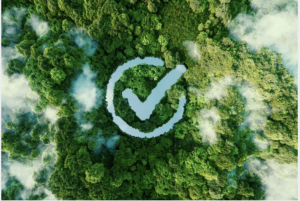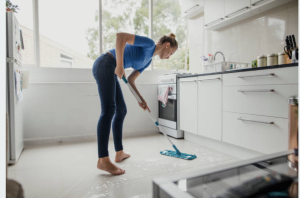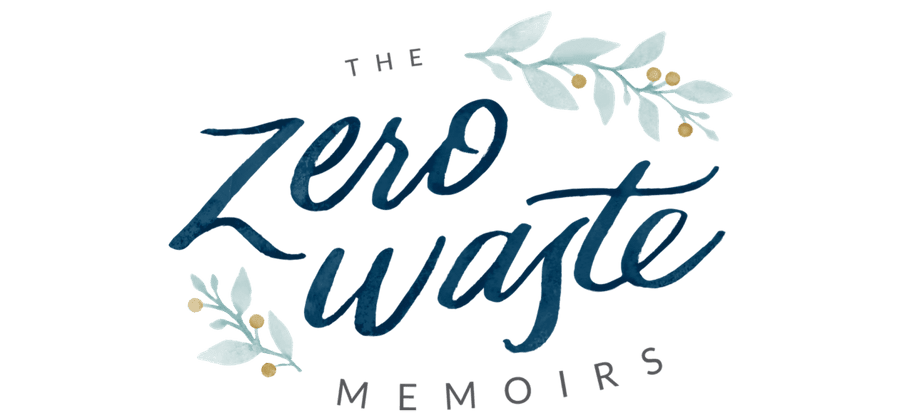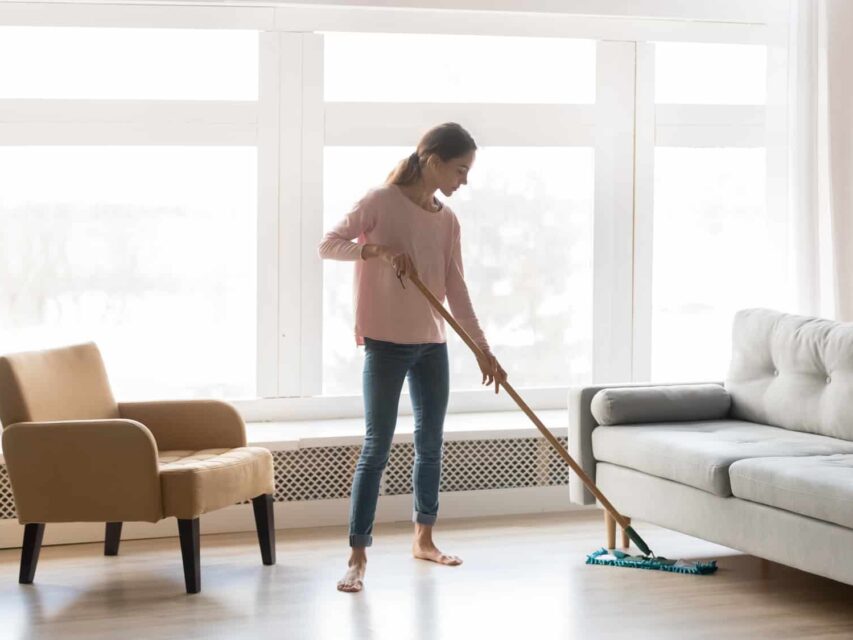Between plastic buckets, single use mopping pads, and chemical-filled disinfectants, your mopping routine can have quite the impact on the environment. If you’re looking to go zero waste or just lessen your impact on the world, adopting a zero waste mopping routine can be a good way to start.
Here’s all you need to know about adopting a new, eco-friendly routine- from what equipment to have to what zero waste floor cleaner to use.

This article may contain compensated/affiliate links. See our full disclosure here.
Zero Waste Mopping Equipment
Let’s start with the basics. Most likely if you open your laundry closet you’ll find a whole bunch of plastic looking back at you! From plastic buckets & mops to plastic bottles housing your disinfectants and floor cleaning solutions – it’s just become the norm for most of us.. But there is a better way. Read on to find out more.
Use What You Have
If you already have a mop and bucket, even if they are made of plastic, your most sustainable option is to just keep using those until they’re on their last legs. At the core of zero waste is to use what you have to reduce overall resource consumption, so keep using that plastic mop and bucket – even if it isn’t as aesthetically pleasing as a wooden mop and stainless steel bucket.
If you really want to do a clean-out and start fresh, donate your old plastic mop & bucket to someone in need rather than sending it to the landfill.

Zero Waste Swiffer
Using a Swiffer is one of the most popular cleaning options out there, and it can be used as a zero waste mop if you abandon the single-use pads in favor of reusable ones. They can easily be made out of scrap fabric, or you can buy eco-friendly ones like these.
To use, spray cleaning solution onto your Swiffer pad and mop, re-spraying as necessary until your floor is clean. You can also put the cleaning solution into the Swiffer itself if it is a model that distils solution for you.
Cuban Mop
Cuban mops are widely used mopping solutions across Latin America and Europe. They are made with two wooden poles to form a T-shape, and a reusable towel is folded over the end of the poles to form a mop head. You can either buy reusable mop cloths, or use any small cotton towel you have laying around.
To use, soak the towel in your solution, ring out the excess, and mop as normal, re-soaking as necessary until your floor is clean. Cuban mops are also generally more water-efficient than other types of mops, as the towel doesn’t soak up as much water and solution as other types of mop heads.
Where to buy a cuban mop?
- Buy from Amazon
- Buy from Amazon below:
Wood and Cotton Mop
If you want to stick with a classic mop, opt for one made of more sustainable materials, like wood for the handle, steel for the clamps, and cotton strips for the head.
To use this kind of mop, dip and wring the mop head in solution until it’s damp, but not dripping. Mop a small section of your floor, and then dip the head into a rinse bucket of water until the dirt you’ve mopped comes off the head into the water. Then dip your mop back into the solution, wring the head, and continue the cycle.
While some people skip the rinse bucket, if your floors are particularly soiled (e.g. if you have big dogs like mine!) you could end up just spreading the dirt around.
DIY Upcycled Mop
If you have an old mop handle and cotton towels laying around, consider upcycling them into a DIY mop. Simply cut the towels into strips, attach to the wooden mop handle using the clamps on the mop handle (if it doesn’t have clamps, use zip or cable ties), and use it like you would any other mop.
This is much cheaper than buying a new one, and it’s always more sustainable to upcycle old materials rather than buying new ones.
Stainless Steel Bucket
If you use a traditional mop, you’re going to need two buckets – one for rinsing, and one for the cleaning solution. Most buckets are made of plastic, so try to find ones made of something like stainless steel instead.
However, these can be pretty expensive when they come with an inbuilt wringer, so try to upcycle old plastic containers or find something second hand if you want something that’s less sleek, but more cost (and environmentally) friendly.
Steam Instead
If you want a straightforward way to clean your floors and a lot of other surfaces around your house, and are willing to make an investment, consider buying a steamer. Using just water, this machine can clean and act as a zero waste disinfectant for a wide variety of surfaces like floors, counters, and fabric.
This method does require buying a product with plastic components, so make sure you invest in a good one that will last for years, or get one secondhand.
Zero Waste Floor Cleaning Solutions
Along with what kind of equipment we use, it’s also important to think about what cleaning solutions we use when working towards a zero waste mopping routine. It’s fairly easy to make your own (even if you’re not the DIY type), but you can purchase eco-friendly solutions too.
Use Sal Suds
Sal Suds is a popular, multi-purpose, super concentrated cleaning solution made by Dr. Bronners. One bottle can last you months, maybe even years!
To use as a mopping solution, combine 3 gallons of hot water with just half a tablespoon of Sal Suds, and 20 drops of tea tree oil for extra antibacterial and antiseptic properties (optional).
Since you just use water and half a tablespoon of concentrate, this is both a cost-effective and low-waste floor cleaner recipe that can be used on all surfaces. If you are mopping just a small area of your home, you may want to scale the recipe down.
Where to buy Sal Suds?
- Buy from Amazon here
DIY: Vinegar Solution for Laminate or Linoleum Floors
There are tons of DIY recipes out there for mopping solutions to different varieties of floor types with less waste and chemicals. If white vinegar is a staple in your house and you have laminate or linoleum floors, this recipe suggests combining 3 parts vinegar with 1 part water and 1 squirt of dish detergent.
DIY: Wood Floor Cleaner and Polish
If you have wood floors, consider using a solution that won’t only clean your floors, but will polish them too. This recipe suggests using one gallon of hot water with ¾ cup olive oil and ½ cup lemon juice. The water and lemon juice will clean, while the olive oil will polish. Leave the solution to air dry and your floors will be left clean and shining!
Changing to a zero waste mopping routine will not only lessen your impact on the environment, but will save you money and take potentially dangerous chemicals and fragrances out of your home. No matter what floors or budget you have, there’s a zero waste mopping routine out there for you.


